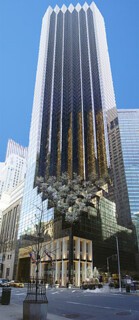Outside Trump Tower
Moira Donegan
In the subway station at Fifth Avenue and 53rd Street you start seeing people holding signs. They move in clusters up or down the stairs to the train, clutching their flaps of cardboard: ‘No Racism’; ‘Immigrants Make America’. Above ground, this strip of Fifth Avenue is empty. Metal fences have been set up by the police along the edge of the pavement, and by 55th street the barriers are concrete. You walk in the middle of the street. Police are everywhere, chests bulging under their blue jackets, making eye contact with one another and giving assessing glances to passersby. The police stand outside Giorgio Armani; the pen of protesters in front of them is separated by the barricades from Dolce & Gabbana: Gucci is in Trump Tower itself. Most of the time now the boutiques are closed.
On the night of 9 November, the day after Donald Trump was elected president, thousands marched up Fifth Avenue, stopping outside Trump Tower. The president-elect’s campaign headquarters are inside, as are the offices of the Trump corporation and the golden penthouse where he lives. We chanted ‘not my president’ and ‘black lives matter’, but some of us were simply screaming. I saw more than one person in tears. That night, the crowd was so dense I couldn’t get close to the tower, but its black glass façade and gold letters were visible from several blocks away. Completed in 1983, the tower is 58 storeys high, with a jagged series of balconies on its southwest corner. It looks like an abandoned Lego project. On the first day of the protests, a man walked out onto one of the balconies to take a selfie above the howling crowd. He raised his middle finger before going back inside.
Several days later, with the crowd much smaller, I got close to the tower for the first time. The police moved immediately to disperse us, one cop pressing his hands on my chest to push me back when I tried to move towards the protest. I was shoved briefly into a group of pro-Trump counter-protesters, half a dozen thick-necked white men. They yelled that we were losers and would be arrested soon, and called me a ‘libtard’.
In our crowd there were a lot of young white women with facial piercings. There were also a number of young black people, some distributing pamphlets, and an older white man who was handing out bananas and muffins wrapped in cellophane. A tiny woman in a hijab clutched her granddaughter’s hand; there were a number of babies. ‘No Trump, no KKK,’ we chanted, ‘no Racist USA.’ The police announced on a loudhailer that they would begin making arrests soon; paddy wagons arrived from 56th Street. No one moved; faces were blank. There is often a jubilatory sense on street protests that something can be done, is being done, to correct injustice. But there is no jubilation outside Trump Tower. There is fear and grief; the chants are shrill with desperation. I watched a woman repeatedly pull on a vape pen. ‘This weed isn’t working,’ she said. At the front of the crowd, a young man wearing a fedora set fire to a bunch of sage and raised it above his head.
A small group began chanting ‘Muslim rights are human rights.’ They may have been thinking of ‘women’s rights are human rights,’ a phrase Hillary Clinton made famous twenty years ago. ‘Wait, whose rights are human rights?’ one woman asked another. ‘Muslim.’ ‘Oh.’ Eventually the slogan picked up steam. At one point that night I was at the front of the crowd, pushed against the metal barricade, with Trump Tower only a pedestrian crossing away. I watched the entrance to see if anyone was coming in or out, but it was impossible to see past the cops standing in front of the golden revolving doors.

Comments